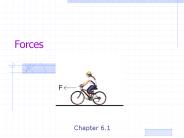Forces - PowerPoint PPT Presentation
1 / 30
Title:
Forces
Description:
Forces & Motion Review Describe Acceleration Describe Acceleration A change in velocity which may be: A change in speed Starting Stopping Speeding up Slowing down ... – PowerPoint PPT presentation
Number of Views:249
Avg rating:3.0/5.0
Title: Forces
1
Forces MotionReview
2
Describe Acceleration
3
Describe Acceleration
- A change in velocity which may be
- A change in speed
- Starting
- Stopping
- Speeding up
- Slowing down
- A change in direction
- Acceleration is caused by unbalanced forces
More
4
Describe Acceleration
- Deceleration is also called negative acceleration
- it means an object is slowing down - When acceleration is calculated, it may be a
negative number
5
Describe Speed
6
Describe Speed
- A way to describe motion
- Average speed - Rate of motion calculated by
dividing the distance traveled by the amount of
time it takes to travel that distance - Constant speed - Speed that does not change
- Instantaneous speed - Speed of an object at any
given time
7
What is the formula used to calculate speed?
8
What is the formula for calculating speed?
- Speed is calculated by dividing distance by time
9
Calculate This Speed
- A football field is about 100 m long. If it takes
a person 20 seconds to run its length, how fast
was the football player running?
10
Calculate this Speed
- A football field is about 100 m long. If it takes
a person 20 seconds to run its length, how fast
was the football player running? - Speed Distance Time
- Speed 100 m 20 s
- Speed 5m/s
Remember to include the UNITS!!
11
Explain Balanced Forces
12
Explain Balanced Forces
- When all the forces acting on an object balance
each other - Balanced forces do not cause a change in motion
13
Describe Friction
14
Describe Friction
- Force that resists motion between two touching
surfaces - Acts in the opposite direction of the objects
motion - Produces heat
15
Explain Inertia
16
Explain Inertia
- Moving objects tend to continue moving unless
acted upon by an unbalanced force - Objects at rest tend to stay at rest unless acted
upon by an unbalanced force - The more mass an object has, the more inertia it
has - More massive objects are harder to start moving
and stop moving - Smaller objects are easier to start and stop
moving
More
17
Explain Inertia
- Newtons First Law on Motion describes the idea
of inertia - An object at rest or in constant motion is acted
upon by balanced forces an unbalanced force
will change the motion - Acceleration of an object at rest or in constant
motion is 0 m/s/s (no motion)
18
Explain Newtons First Law of Motion
19
Explain Newtons First Law of Motion
- Describes the idea of inertia
- Click the link below to observe the law
- http//archive.ncsa.uiuc.edu/Cyberia/VideoTestbed/
Projects/NewPhysics/newtons_1.html - When you are finished, click the back button on
your browser to return to this tutorial
20
Explain Newtons Second Law of Motion
21
Explain Newtons Second Law of Motion
- Describes motion created by unbalanced forces
- Mass and acceleration change in opposite ways
- The more mass an object has, the more force it
take to accelerate the object, the slower it
accelerates - The less mass an object has, the less force it
take to accelerate the object, the faster it
accelerates
More
22
Explain Newtons Second Law of Motion
- Click on the link below to observe the law
- http//archive.ncsa.uiuc.edu/Cyberia/VideoTestbed/
Projects/NewPhysics/newtons_2.html - When you are finished, click the back button on
your browser to return to this tutorial
23
Explain Newtons Third Law of Motion
24
Explain Newtons Third Law of Motion
- Describes why forces act in pairs
- For every action there is an equal and opposite
reaction - Action and reaction forces are equal forces
acting in opposite directions on different
objects
25
Explain Newtons Third Law of Motion
Click the link below to observe the
law http//archive.ncsa.uiuc.edu/Cyberia/VideoTes
tbed/Projects/NewPhysics/newtons_3.html
26
Distinguish Between Speed Velocity
27
Distinguish Between Speed and Velocity
- Speed describes distance and time
- Velocity describes distance, time, and direction
28
How Can Forces Affect Objects?
29
How Can Forces Affect Objects?
- Slow them down
- Speed them up
- Stop them
- Start them
- Change their direction
- Change their shape
30
This power point courtesy of the following
- http//www.usoe.k12.ut.us/curr/science/sciber00/8t
h/forces/sciber/intro.htm































